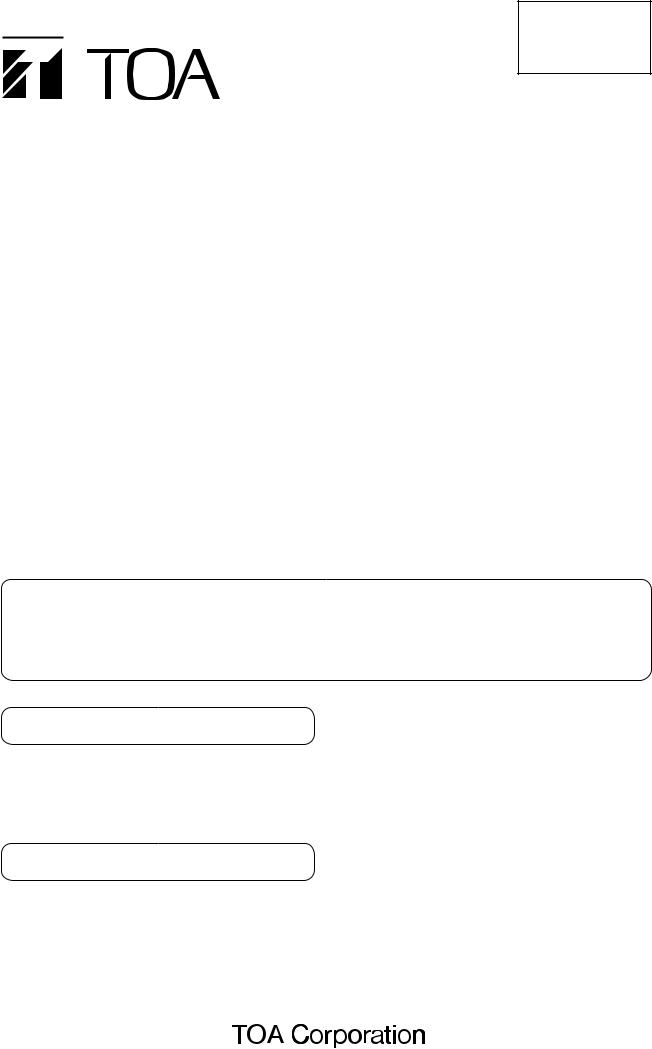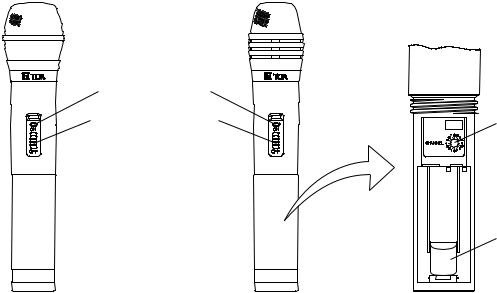Toa WM-4220 User Manual [en, de, es, fr]

English: page 1
Deutsch: seite 5
Français: page 9
Español: page 13
OPERATING INSTRUCTIONS
UHF WIRELESS MICROPHONE |
WM-4210 |
|
WM-4220 |
Please follow the instructions in this manual to obtain the optimum results from this unit. We also recommend that you keep this manual handy for future reference.
1. SAFETY PRECAUTIONS
•Be sure to read the instructions in this section carefully before use.
•Make sure to observe the instructions in this manual as the conventions of safety symbols and messages regarded as very important precautions are included.
•We also recommend you keep this instruction manual handy for future reference.
Safety Symbol and Message Conventions
Safety symbols and messages described below are used in this manual to prevent bodily injury and property damage which could result from mishandling. Before operating your product, read this manual first and understand the safety symbols and messages so you are thoroughly aware of the potential safety hazards.
 WARNING
WARNING
 CAUTION
CAUTION
Indicates a potentially hazardous situation which, if mishandled, could result in death or serious personal injury.
Indicates a potentially hazardous situation which, if mishandled, could result in moderate or minor personal injury, and/or property damage.
 WARNING
WARNING
•To prevent the electromagnetic wave from badly influencing medical equipment, make sure to switch off the unit's power when placing it in close proximity to the medical equipment.
 CAUTION
CAUTION
•When the unit is not in use for 10 days or more, be sure to take the battery out of the unit because battery leakage may cause personal injury or contamination of environment.
•Make sure to observe the following handling precautions so that a fire or personal injury does not result from leakage or explosion of the battery.
·Do not short, disassemble, heat nor put the battery into a fire.
·Never charge batteries of the type which are not rechargeable.
·Do not solder a battery directly.
·Be sure to use the specified type of battery.
·Note correct polarity (positive and negative orientation) when inserting a battery in the unit.
·Avoid locations exposed to the direct sunlight, high temperature and high humidity when storing batteries.

2. GENERAL DESCRIPTION
The WM-4210 Wireless Microphone employs a dynamic microphone element and is suitable for vocal applications.
The WM-4220 Wireless Microphone employs an electret condenser microphone element and is suitable for speech applications.
3. FEATURES
•One frequency can be selected from 16 operating frequencies of 690 – 865 MHz.
•An optimized PLL-synthesizer minimizes the oscillation frequency drift resulting from the ambient temperature or voltage fluctuation.
•Battery lamp indicates battery consumption to prevent the unit from malfunctioning when the battery level remarkably decreases.
4. HANDLING PRECAUTIONS
•Do not expose the unit to rain or an environment where it may be splashed by water or other liquids, as doing so may result in unit failure.
•Never open nor remove the unit case to modify the unit. Refer all servicing to your nearest TOA dealer.
•Take care not to drop the unit onto the floor nor bump it against a hard object as the unit could fail.
•Do not place the unit in locations of high temperature (ex. in a car parked in summer) or high humidity as the unit could fail.
•Do not use the unit in locations where it is exposed to seawater.
•To clean, use a dry cloth. When the unit gets very dirty, wipe lightly with a cloth damped in a dilute neutral cleanser, then wipe with a dry cloth. Never use benzine, thinner, or chemically-treated cleaning towel.
•Avoid using a mobile telephone near the wireless microphone in use. Noise could be picked up.
5. NOMENCLATURE
[WM-4210] |
[WM-4220] |
Power/Battery lamp (Orange LED)
Power ON/OFF switch |
Channel select switch |
Battery clip
2

6. BATTERY INSERTION
Step 1. |
Hold the microphone body and rotate the microphone |
|
|
grip counterclockwise to remove it. |
|
Step 2. |
Insert the battery 6LR61 (Alkaline 9 V) according to |
|
|
the instructions attached to the inside of the battery |
|
|
compartment. Pay attention to the correct polarity |
|
|
when inserting the battery. |
|
Step 3. |
Replace the microphone grip by sliding and rotating it |
1 |
|
clockwise. |
|
Battery replacement
•A brand-new battery will provide the power enough to operate the unit continuously for 10 hours.
•As long as the battery has sufficient power for the microphone to function properly, the orange LED will light. When the orange LED starts to fade and then flash, replace it with a new one.
2
Orange LED
Indicates the battery level by lighting or flashing.
7. OPERATION
Step 1. Make sure that the receiver and the wireless microphone are of the same channel (frequency).
Step 2. If they are not identical in channel, you have to adjust the channel switch.
Step 3. Place the microphone ON/OFF switch in the ON position.
The orange LED indicates the circuit is active.
Step 4. Make sure to shift the ON/OFF switch back to the OFF position after using the wireless microphone.
8. OPERATIONAL HINTS
•The microphone's service distance is 3 – 120 m. When the microphone user moves in a facility, signal dropouts (momentary losses of signal reception) may be encountered. These dropouts are caused by the building's architectural designs or materials which block the travel of or reflect the radio signal. If this occurs, the user needs to change locations for better signal reception.
•The proper operation of your wireless system may be interfered with by other system operating on the same frequency. In such cases, change the operating frequency of your system. (As to dealing with the interference, refer to the operating instructions of the wireless tuner.)
•Should you have any questions regarding the use or availability of TOA wireless products, please contact your local TOA dealer.
9. CHANNEL NUMBER SETTING
Step 1. Switch off the power. Rotate the microphone grip counterclockwise to remove it.
Step 2. Using the supplied screwdriver, set the Channel setting switch pointer to the desired channel number.
Step 3. Replace the microphone grip.
Note: Make sure that the wireless microphone is identical to the wireless tuner in the channel number. Should the microphone's setting differ from that of the tuner, the tuner does not receive the microphone signal.
3

10. SPECIFICATIONS
Model No. |
WM-4210 |
|
WM-4220 |
Microphone Element |
Dynamic type |
|
Electret condenser type |
|
Cardioid pattern |
|
Cardioid pattern |
|
|
|
|
Emission |
|
F3E |
|
|
|
|
|
Frequency Range |
690 – 865 MHz, UHF |
||
|
|
|
|
Selectable Channel |
|
16 channels |
|
|
|
|
|
RF Carrier Power |
|
Less than 50 mW |
|
|
|
|
|
Tone Frequency |
|
32.768 kHz |
|
|
|
|
|
Maximum Input Level |
130 dB SPL |
|
125 dB SPL |
|
|
|
|
Maximum Deviation |
|
±40 kHz |
|
|
|
|
|
Audio Frequency Response |
100 – 12,000 Hz |
|
200 – 12,000 Hz |
|
|
|
|
Dynamic Range (AF Circuit) |
More than 100 dB (with WT-4810) |
||
|
|
|
|
Battery |
|
6LR61 (9 V x 1) |
|
|
|
|
|
Battery Life |
More than 10 hours (alkaline) |
||
|
|
|
|
Indicator |
Power/Battery lamp (orange LED) |
||
|
|
|
|
Antenna |
|
Built-in type |
|
|
|
|
|
Operating Temperature |
|
–10 to +50°C |
|
|
|
|
|
Finish |
Resin, coating, dark gray |
||
|
|
|
|
Dimensions |
ø50 x 235.2 mm |
|
ø45 x 235.2 mm |
|
|
|
|
Weight |
270 g (with battery) |
|
250 g (with battery) |
Note: The design and specifications are subject to change without notice for improvement.
• Accessories |
|
Microphone holder (with stand adapter) ............... |
1 |
Screwdriver (for setting) ....................................... |
1 |
Storage case ........................................................ |
1 |
License requirement
Operation is subject to the following two conditions:
(1) This device may not cause harmful interference, and (2) this device must accept any interference received, including interference that may cause undesired operation.
4

|
Bedienungsanleitung |
UHF Drahtlos-Mikrofon |
WM-4210 |
|
WM-4220 |
Bitte folgen Sie den Hinweisen in dieser Bedienungsanleitung, um optimale Ergebnisse zu erzielen. Bewahren Sie die Bedienungsanleitung sorgfältig und zugänglich auf.
Bitte entnehmen Sie aus der beiliegenden Tabelle die Frequenzen, die im jeweiligen Staat genutzt werden können. Beachten Sie unbedingt auch den folgenden Hinweis!
WICHTIGER HINWEIS!
Melden Sie Ihr Drahtlossystem vor dem ersten Einschalten bei der zuständigen Behörde an.
Erläuterung für Deutschland:
Das Drahtlosmikrofon darf erst nach Zuteilung von Frequenzen zur Nutzung für den Betrieb bei der zuständigen Außenstelle der Regulierungsbehörde für Telekommunikation und Post (RegTP) und auch nur auf den zugeteilten Frequenzen betrieben werden! Bei Zuwiderhandlungen kann die Behörde Strafmaßnahmen gegen Sie erwirken.
Antragsformulare erhalten Sie bei der Regulierungsbehörde für Telekommunikation und Post (RegTP) oder über das Internet unter "www.regtp.de".
Von der Homepage der RegTP navigieren Sie wie folgt:
•(linke Spalte) Regulierung Telekommunikation...
•(rechte Spalte) Frequenzverwaltung
•(rechte Spalte) Funkdienste-spezifische Angelegenheiten
•(rechte Spalte) Nichtöffentlicher Mobilfunk, Satellitenfunk
•(rechte Spalte) Anträge und Ausfüllhinweise
•(mittlere Spalte): laden Sie die Formulare unter der Überschrift "Durchsage-Funk".
DER BETRIEB IM FREQUENZBEREICH VON 863,1 MHZ BIS 864,9 MHZ IST NICHT ANMELDEPFLICHTIG.
1. SICHERHEITSHINWEISE
Die folgenden Sicherheitsund Warnhinweise sind zu Ihrem Schutz aufgeführt. Bitte lesen Sie diese sorgfältig durch.
Zeigt eine potenziell gefährliche Situation auf.
WARNUNG Die Nichtbeachtung der Warnhinweise kann zu Verletzungen, möglicherweise auch mit tödlichem Ausgang, führen.
•Das Mikrofon bitte nach Gebrauch immer ausschalten. Insbesondere ist darauf zu achten, dass es zu keiner gegenseitigen Beeinflussung mit Medizintechnischen Geräten kommt.
Zeigt eine potenziell gefährliche Situation auf.
ACHTUNG Die Nichtbeachtung dieser Hinweise kann zu Verletzungen oder Sachschäden führen.
•Das Funkmikrofon wird mit Batterien betrieben.
•Verwenden Sie nur die angebenen Batterietypen und achten Sie beim Einsetzen auf die korrekte Polung.
•Nehmen Sie die Batterien aus dem Mikrofon, wenn dieses länger als 10 Tage ausser Betrieb genommen wird. Auslaufende Batterien können zu Schäden am Mikrofon führen.
•Werfen Sie verbrauchte Batterien nicht in den Müll oder ins offene Feuer. Schließen Sie keine Batterien kurz und öffnen Sie diese niemals.
•Setzen Sie Batterien auch nicht starkem Sonnenlicht, Hitze oder Regen aus. Laden Sie niemals Batterien auf.
5
